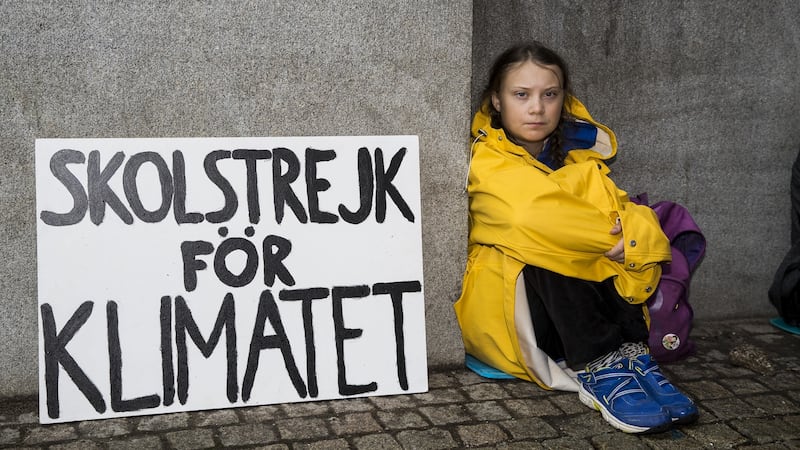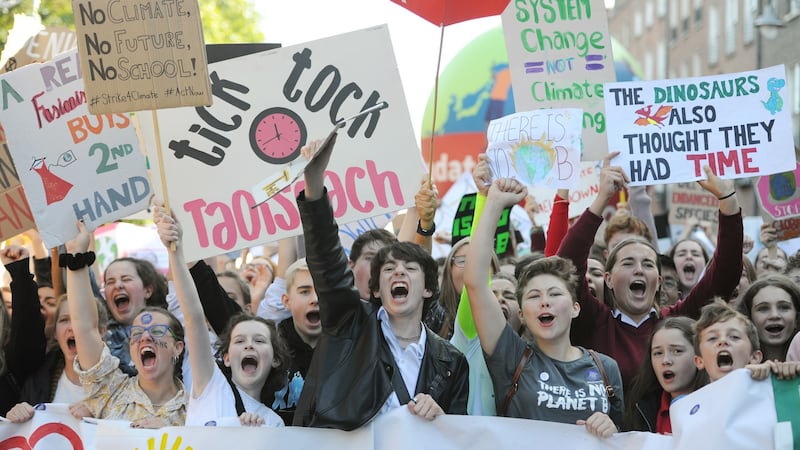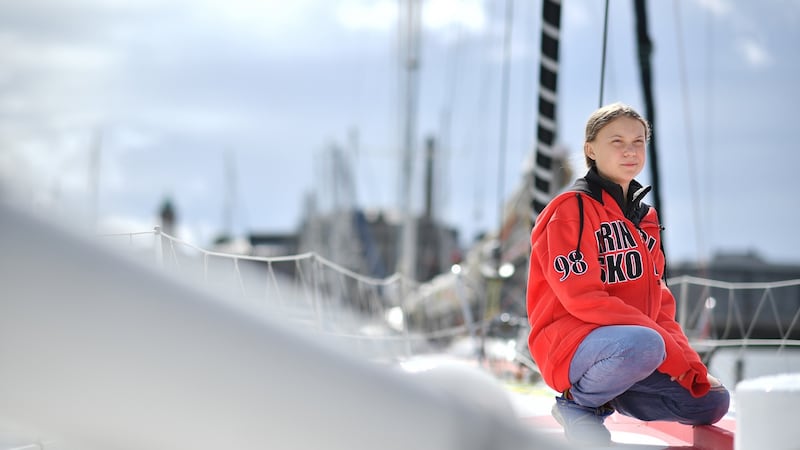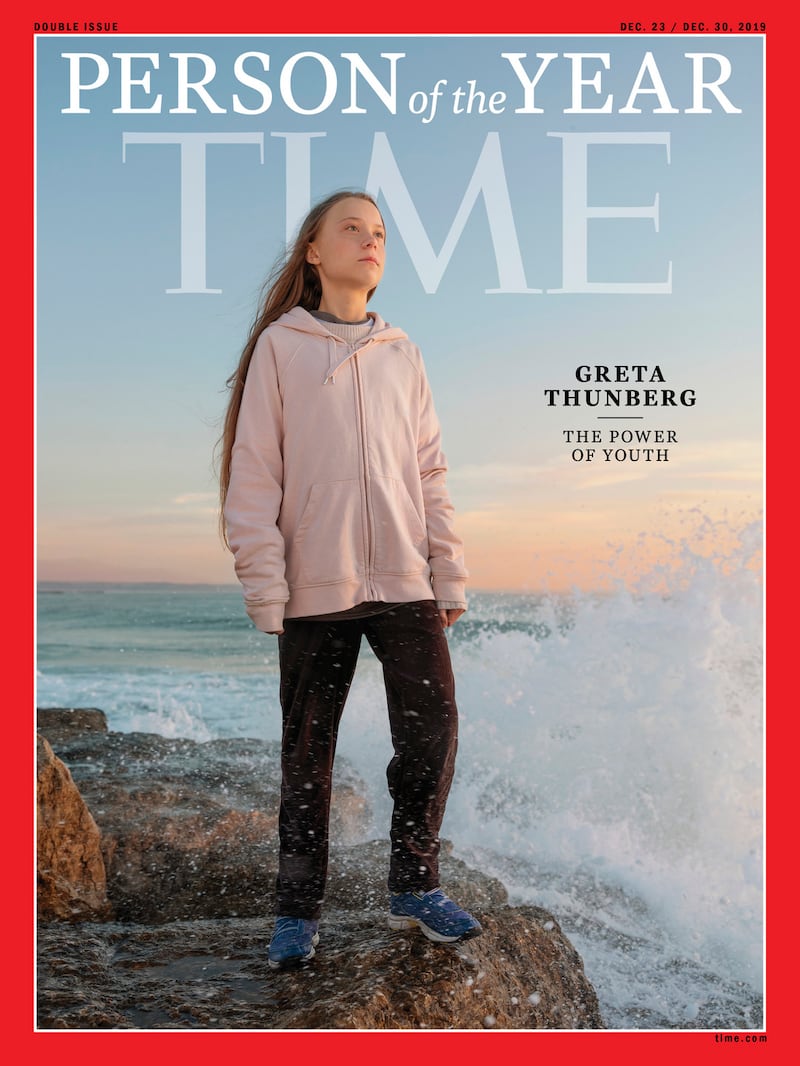On a grey August morning in 2018, Ingmar Rentzhog dropped his tearful three-year-old son off to his first day of kindergarten in their home city of Stockholm and walked to work.
The climate activist and entrepreneur’s route took him past the Swedish parliament or Riksdag. That morning, August 20th, there was a girl sitting on the ground outside, a bright backpack by her feet. She had a sign. “Skolstrejk för Klimatet’ or ‘School Strike for Climate,” it said. She also had a small pile of leaflets, typed up in Comic Sans and held down by a stone.
“We kids most often don’t do what you tell us to do. We do as you do. And since you grown-ups don’t give a shit about my future, I won’t either. My name is Greta,” the leaflets read.
Rentzhog wrote up a post about her for Facebook. “During the time I was there, only one passerby walked up and took her info sheet. Nobody but me talked to her,” he said in a post accompanied by photographs of the small-boned teenager, who looked at once tiny, vulnerable and powerful, sitting among the cobbles and strewn cigarette butts.
There is something indefinably arresting about those early images of Greta Thunberg: the juxtaposition of her modern leopard-print leggings and backpack against the self-conscious grandeur of the building; her knuckles kneading together; her refusal to catch the photographer's eye; her mouth set in a line that is unmistakably fury. With her plaits and her plain pink socks, she could be a child of any age, of any century. And yet, her message is very much of this time.
The post went moderately viral, eliciting 2,100 comments and 5,800 shares.
That afternoon, a local newspaper reported on the teenager and her school strike. Within days, a handful of other protesters had joined her, and more media. At the end of her second week, the Guardian observed that she was “a diminutive girl with pigtails and a fleeting smile – not the stereotypical leader of a climate revolution”.
If she wasn’t the “the stereotypical leader of a climate revolution” in 2018, she is now. “What if a million school children skipped school for the climate and instead sat outside parliaments and town halls? That would carry an enormous weight,” she told Rentzhog early on, one of those dreamy, idealistic things only teenagers get away with saying.

Or so you’d think. As it turned out, she smashed that goal by March 15th, 2019, as one million children turned out in 2,200 strikes across 125 counties. By September 20th that year, the number had grown to four million protesters, still mostly children. She took a “gap year” off school, which finishes this week. Greta Thunberg is going back to school.
* * *
“It’s hard to believe that the name Greta Thunberg is only known to us for two years,” says Pippa Hackett, Green Party Minister of State for land use and biodiversity.
During the two years since she first exploded into public consciousness, Thunberg has given speeches to the United Nations Climate Action Summit in New York and the European Parliament. She has met Barack Obama, and fixed his successor with an instantly meme-worthy icy stare.
She has travelled by yacht to the United States in a stripped-down racing super-yacht with a blue plastic “poo only” bucket by way of luxury.
She was planning to drive with her father to the COP25 climate summit in Santiago, Chile, in a Tesla loaned to them by Arnold Schwarzenegger. They got as a far as Los Angeles when the whole thing was relocated for security reasons to Madrid. So it was back on to another boat for three more weeks of being tossed around and defecating into a bucket.
She elicits hope, admiration and even awe in people many times her age. There’s no small degree of envy, among activists, scientists and climate researchers, for her ability to mobilise attention behind a climate message some feel they have been shouting into the void for two decades.
She has also been the subject of speculation, vitriol and a fair amount of suspicion. The circumstances of Rentzhog’s first meeting with her, and his motivations, were subsequently torn apart in a raft of “Who’s REALLY behind 16-year-old Thunberg?” articles which claimed to unpick a concerted campaign to transform the young Swede into a global heroine.
It’s a product of how much speculation surrounds her that, if you type her name into Google, the search engine suggests the following phrases: “Who funds Greta Thunberg.” “Greta Thunberg parents.” “Is Greta Thunberg rich.” “Greta Thunberg speech.” “Greta Thunberg meme.” “Greta Thunberg school dropout.”
Donald Trump said she had an "anger management problem"; Putin called her a "kind but poorly informed teenager". She instantly adopted both in her Twitter bio.
* * *
Two years in, much of the ugly rhetoric has faded away. It’s not so much that it is hard to keep up the cynicism about a teenager who twice crossed the Atlantic in a boat to prove her point about the need to reduce emissions – more that it’s hard to keep it up in the face of a teenager who doesn’t care.
Thunberg’s implacability in the face of the most appalling abuse is genuine. She simply has bigger things on her mind – namely, what she calls the existential threat facing humanity.
It’s also fair to ask what those two years have managed to achieve. In Madrid in December for the UN climate talks, she told activists that a year of school strikes had “achieved nothing” and pointed out that in the four years since the Paris accord, greenhouse gas emissions had risen 4 per cent. But her point was only ever to get people in power to listen to the science and act themselves.
Though the much-anticipated “green wave” didn’t fully materialise during the 2019 European elections, there was an unmistakable, Thunberg-shaped green surge.

In Dublin, Brussels, and Berlin, Green candidates topped the polls. In this context, too, it’s worth remembering that the young people who have come of age with Thunberg will start to get the right to vote over the next year or two.
To those who know her in real life – including 17-year-old Cork climate activist Saoi O’Connor who is also coming to the end of a year of homeschooling in order to focus on climate activism – it’s difficult to associate the real person with the figure that inspires such vitriol and passion.
“I think people expect this larger-than-life figure for me to describe, and honestly, she’s my friend. I have a lot of climate activist friends. She’s cool. The main difference really is that often when I’m talking to her, we end up being surrounded by cameras,” O’Connor says.
* * *
Grace O’Sullivan, the Green Party MEP who was elected in 2019, met Thunberg when she addressed the European Parliament. “She has never tried to be anything more than who she was. There’s a real calmness about her … She has brilliant advice around her, and she has the capacity to assimilate it. She knows what she needs to influence. Her frustration is looking at these so-called adults who should be trying to protect their fellow citizens and they’re not.”
David Attenborough disagreed with her assessment that the strikes had "achieved nothing". Last December, the 93-year-old said told her she had "achieved things that many of us who have been working on it for 20-odd years have failed to achieve, and that is you have aroused the world".
Thunberg “has had an extraordinary impact on public consciousness and political focus on climate change over the past two years,” says Oisín Coghlan of Friends of the Earth.
Her impact, he adds, should be seen as part of a series of new waves of grassroots, “self-propelled” activism, including student protests, Extinction Rebellion and the anti-fracking movement. “What she has done more than anything is unleash public concern, focus it, by her courage in taking a stand on her own,” Coghlan says.
Grace O’Sullivan goes further. “As a climate activist and an environmental activist, I put her among the great individuals, even someone like Mahatma Gandhi – huge characters who recognise the importance of engaging citizens to stand up and let it be known to the legislators that this destructive way of living has to end.”
“Why was it that what we were saying since the 1980s was not having the same impact?” O’Sullivan wonders. “It is timing definitely” and the deepening urgency of the climate crisis. “But it’s also her honesty. Her integrity.”
Coghlan believes Thunberg’s power lies in “some combination of her own personality, her skillset and some degree, she would say herself, of Asperger’s. There’s no artifice. She doesn’t pull her punches,” he says.
This, in particular, has been a wake-up call to other climate activists. Typically, Coghlan says, “you try to start where your audience are, and bring them with you. And that often means I do pull my punches…You’re trying to come across as reasonable to the average listener of the mainstream Irish broadcast news programme. And that means not starting with the unvarnished, alarming truth.”
* * *

There’s none of that with Greta Thunberg. In the speech she made at Davos in 2019, she began with the words, “Our house is on fire.”
That September, at the UN climate summit in New York, she said: “You have stolen my dreams and my childhood with your empty words.”
She would later tell a Swedish newspaper people quoting just those three lines “makes me sound like an idiot” and she wouldn’t be doing emotion next time. “Apparently I am quite bad at giving speeches,” she said, though many would beg to differ.
One of those who would challenge it is Prof Pete Lunn, head of the behavioural research unit at the ESRI. “There is a strain of behavioural science research that’s been done on persuasion, in particular in science communication. And what it shows is that narrative is more powerful than statistics.”
“For somebody like me,” he admits, “this is quite painful. Of course I want inferences and policy decisions to be made based on sound, quantitative analysis. But lots of people find that very abstract and not very motivating, and they’re often not persuaded by statistical arguments.”
And then, “along comes this young person who is scientifically literate, has read the evidence and has absorbed the impact this has for her generation. And she’s feeling betrayed by the older generation. Suddenly what we have is a story ... a classic story of intergenerational injustice.
“Once a story has a kind of human narrative, it becomes more persuasive than all of those years and years of statistics and scientific build-up of evidence and argument.”
This is not something that can be manufactured. For the story to have impact, he warns, it has to be real.
“Greta takes on the system, she takes on governments, she takes on the United Nations. That sense of David versus Goliath is always captivating. She is smart yet vulnerable, and she doesn’t let that stop her,” says Pippa Hackett.
* * *
Dr Jane Suiter, associate professor in the school of communications at Dublin City University points to Thunberg’s own powers of persuasiveness, but also her “generation’s willingness to put the social good above themselves … Because it wasn’t just her. There are teenagers all over Europe, Australia, New Zealand who are doing it too. They’re remarkable. They drive older men completely bonkers.
“It’s almost hilarious the amount of men in their 40s to 60s who are completely triggered by these schoolgirls. They can’t cope [with the fact] that they are leading this kind of change. In fact, she is the figurehead of a very large generational movement that we probably need as a planet.”

Saoi O’Connor is one of those “triggering” teenagers. O’Connor sat outside Cork City Council for two weeks in January, almost entirely alone for the first week. “We are a movement that is primarily led by young women, and I think that most of the people who are upset and feel challenged with it are men.
“I think that a lot of the backlash against Greta is quite misogynistic. It’s very much a challenge to the status quo – us connecting and building and organising … If I was a person with systemic power, I would be afraid.”
Thunberg, says O’Sullivan, has always been “highly strategic” about building her movement. She has known what she wants to achieve and how she is going to get there.
In this sense, it’s no surprise that now she has an army behind her she would go back to school. She has made no secret of her desire to live “a normal life”.
What will happen to the movement she unleashed? “Even if we don’t see as much of her, it’s not the end of something,” says Coghlan. “She has demonstrated what is possible.”
“It’s not about Greta, and she would be the first person to say that,” O’Connor agrees. “I think that’s important to people to see that someone who is so small could have this huge ripple effect … I don’t think there’s anything unique in her message, [but] for some reason when it came from her, it resonated with people. That’s good because it needs to resonate eventually, it needs to start sinking in.”
O’Connor says the movement of young people will continue to build on the work of the older generation of NGOs, scientists and activists. “This movement has achieved so much in terms of awareness, changing the public consciousness, making this a more mainstream issue. But we have to look at the emissions curve and it’s still rising.”
O’Sullivan gets emotional when she meets young activists. “I always have to gather myself. I’m so inspired to see these young people who have way more knowledge than I had at their age,” says O’Sullivan. If they’re not inspired by the climate science, they’re inspired by the idea that runs counter to their strong sense of social justice that “the people who are least to blame for climate change are the ones to suffer most”.
“My hope is that Greta is going back to school, but she certainly isn’t going to go away. Her job is far from complete. She probably didn’t realise the impact she would have in terms of mobilising people. She’s a figurehead now.”


















